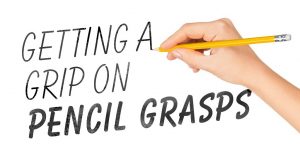
This worksheet provides an overview of pencil grasps often observed in children and treatment options when grasp patterns are not functional.
| Grasp | Description | Photos |
| Tripod Grasp | The thumb and index fingers “pinch” the pencil just above the tip and the DIP joint of the middle finger is placed behind the pencil, creating a tripod support as the child writes. There are three types of tripod grasps: Static Tripod Grasp: This grasp typically develops between the ages of 3 and 4. The child forms the grasp with the fingers, but movement is initiated at the wrist. Dynamic Tripod Grasp: This grasp usually develops by age 5. The child forms a tripod grasp with the fingers and moves the fingers to move the pencil. Lateral Tripod Grasp: This is a variation of the tripod grasp, in which the thumb is placed next to the index finger, rather than opposite, to brace the pencil. The web space is closed, and more wrist extension is required to write using this grasp. |
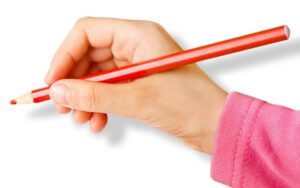 |
| Quadrupod Grasp | The thumb, index and middle fingers hold the pencil and the DIP joint of the ring finger is placed behind the pencil, creating a four sided or quadrupod support. There are two types of quadrupod grasps: Static Quadrupod Grasp: Typically develops between the ages of 3 and 4. The child forms the grasp with the fingers, but movement is initiated at the wrist. Dynamic Quadrupod Grasp: The child forms the grasp with the fingers and moves the fingers to move the pencil. |
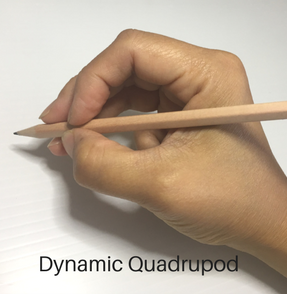 Quadruped Grasp Quadruped Grasp |
| Adapted Tripod Grasp | This grasp is often used by children with poor finger strength, as it requires less strength to stabilize the pencil. The shaft of the pencil is placed between the index and middle fingers while the thumb, index and middle fingers form the tripod grasp just above the pencil tip. | 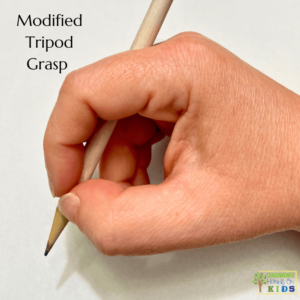
Adapted Tripod Grasp |
Developmental Grasps – Use of one of these grasps after age 5 is considered dysfunctional.
| Grasp | Description | Photos |
| Palmar Supinate Grasp | Also called gross grasp, cylindrical grasp, or fisted grasp. This grasp typically develops by ages 12 to 18 months and is used for scribbling. A normally developing child will transition to the next developmental grasp by age 2. The pencil is held with the thumb and all fingers curled around the shaft, with the tip of the pencil on the ulnar side of the hand. The child supinates the forearm slightly while scribbling. | 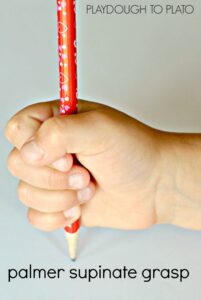 Palmar Supinate Grasp Palmar Supinate Grasp |
| Digital Pronate Grasp | This grasp emerges around age 2. A normally developing child will transition to the next developmental grasp by age 3. The child holds the pencil with the forearm pronated and the palm down. The shaft of the pencil is held by curling all four fingers around the shaft, tucking the pencil into the palm. The thumb is placed along the shaft of the pencil. The tip of the pencil is on the radial side of the hand. | 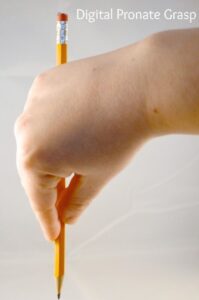 Digital Pronate Grasp Digital Pronate Grasp |
| Multi-finger Transitional Grasp | Also called five finger grasp or interdigital grasp. This grasp emerges around age 3 and may be used alternately with other grasps as the child learns to control the pencil. Normally developing children will transition to a static tripod or quadrupod grasp by age 4. The thumb is placed on one side of the pencil shaft and 4 or 5 fingers are placed on the other side. The child moves the forearm, wrist and hand as a unit while drawing or writing. | 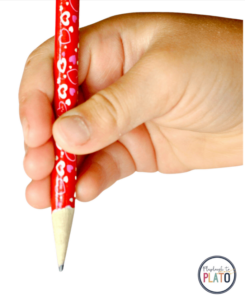 Multi-finger Transitional Grasp Multi-finger Transitional Grasp |
Dysfunctional Grasps – these grasps do not follow the normal developmental sequence and are considered inefficient for normal handwriting. A point to consider regarding pediatric practice is that as handwriting instruction has decreased in importance in public and private education, the prominence of dysfunctional pencil grasps has increased. There are many dysfunctional grasps, but these are two of the most common.
| Grasp | Description | Photos |
| Thumb Wrap Grasp | This grasp is often confused with the lateral tripod grasp, as the positioning of the thumb only varies slightly. Instead of positioning the thumb next to the index finger for additional support, the thumb slides forward and wraps around the index finger, completely closing the web space. Movement is limited in the fingers, with more wrist movement used to compensate. This grasp often develops when a child has weak hand and finger muscles or poor prehension patterns. |  Thumb Wrap Grasp Thumb Wrap Grasp |
| Thumb Tuck Grasp | The thumb is placed on the pencil shaft but is tucked under the DIP joint of the index finger. The tip of the index finger may be off the pencil. The tip of the middle finger and the DIP joint of the ring finger hold the pencil and initiate movement. This grasp may form in children who have unstable CMC joints in the thumb. | 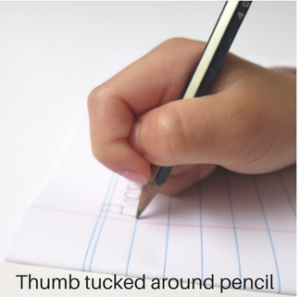 Thumb Tuck Grasp Thumb Tuck Grasp |
Treatment for Dysfunctional Pencil Grasps – these treatment techniques can be used to help children progress from dysfunctional to functional pencil grasps. Here are a couple of important points to remember when attempting to change pencil grasps:
1. Early intervention is very important. Children’s motor patterns related to pencil grasps are usually ingrained in the brain by age 8 or 9, after which time it is very difficult to change the pattern.
2. Children with motor control, motor learning or visual impairments may have more difficulty changing pencil grasps and may require additional intervention in other areas.
3. Children with sensory processing problems may have difficulty feeling where their fingers are in relation to the pencil and may have difficulty reproducing functional grasp patterns.
| Problem | Resulting Grasp | Treatment | Photo |
| Poorly integrated palmar reflex – the fingers show a tendency to curl when the palm is pressed. | Palmar Supinate Grasp | -Squeezing and opening the hands repeatedly, either with hands empty or using a small stress ball. -Play activities that require strong, forceful grasp, such as playing on monkey bars or swinging on a trapeze bar. -Forceful hand based heavy work, such as putty exercises with resistive putty, squeezing cylindrical glue bottles, squeezing a hand exerciser. -Picking up small items with tweezers or connected chopsticks. |

|
| Inadequate prehension patterns – the fingers do not form a quality or forceful tip or palmar pinch. Cause may be poor thumb stability, low finger strength, motor learning or motor control problems. | Multi-finger Transitional Grasp, Lateral Grasp, Thumb Wrap Grasp, Thumb Tuck Grasp, Hook Grasp | -Putty exercises focusing on tip and palmar pinch -Activities that require pinch – placing clothespins, placing small pegs, popping bubble wrap. -Coloring using broken crayons – the size of the crayons forces the fingers to form a tripod grasp to hold the crayons. Hand over hand assistance may be required at first to provide input for appropriate finger position and force of grasp on the crayon. |
|
| Decreased thumb strength | Lateral Grasp, Thumb Tuck Grasp | -Putty exercises focusing on thumb strength. -Lateral pinch activities including placing clothespins using lateral pinch, push-button toys using the thumb. -A soft Thumb Spica splint may be necessary if decreased thumb strength is not correctable through exercise and activity. |
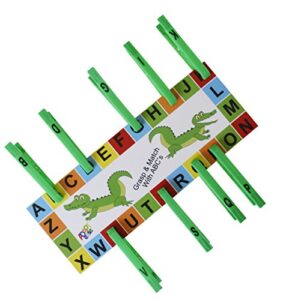 |
| Difficulty with finger isolation – the fingers tend to move as a unit, rather than moving individually. | Palmar Supinate Grasp, Multi-finger Transitional Grasp, Hook Grasp | -Activities that isolate the index finger – pointing, pushing buttons, finger painting with one finger. – “Flicking” games – one finger is used to flick an object at a target. -Pressing keys on a piano or keyboard with hands in set position (no hunt and peck). -Holding a small toy or coin in the ring and little fingers while writing to keep them tucked. -Coloring using broken crayons – may incorporate holding a small toy in the ring and little fingers. |

|
Adaptations for Pencil Grasp – these adaptations may be used while a child’s functional grasp is developing, or to adapt a dysfunctional grasp when remediation is not possible. If a child develops a functional grasp, the adaptation may be faded, but should be reintroduced if the child reverts to a dysfunctional grasp.
| Adaptation | Description | Purpose | Photo |
| Pencil grip | A plastic device that slides on to the shaft of the pencil, -Pencil grips come in many sizes and styles. |
A pencil grip changes the size or shape of the pencil to accommodate or train the fingers. -Many adults try to correct problems with grasp patterns by introducing a pencil grip before the root of the grasp problem is determined. -Different pencil grips are used to correct all the dysfunctional grasps listed. |
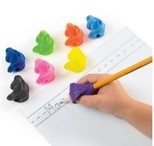 |
| Pencil weights | Pencil weights are small washer or nut shaped weights that slide on to the pencil shaft. They are held on with rubber rings. | Pencil weights help a child to hold a pencil with the shaft positioned so that it is resting in the web space. This adaptation is often used with children who use Multi-finger Transitional Grasp or Hook Grasp. | 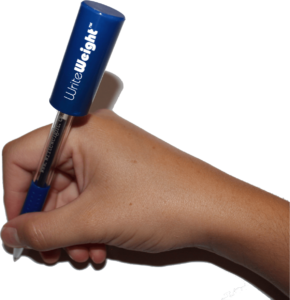 |
| Triangular pencils | Standard or enlarged pencils that have three sides rather than a round or hexagon shape. | Triangular pencils give a child defined surfaces to help with finger placement when forming a tripod grasp. Often used with children who use Thumb Wrap Grasp. | 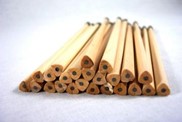 |
| Writing charms | A small toy that is attached to a piece of elastic or stretchy plastic. The other end of the elastic has a loop that slides on to the pencil shaft. | The small toy is held by the ring and little fingers while writing, to encourage finger isolation and static or dynamic tripod grasp. Often used to correct Palmar Supinate Grasp, Multi-finger Transitional Grasp, Hook Grasp. | 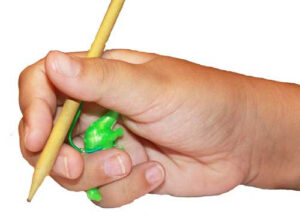 |
| Elastic writing aid | This device can be made from a rubber band or circular piece of elastic. A small loop is tied into one side of the band to hold the pencil. The larger loop is placed around the child’s wrist. -A commercial version of this adaptation called Handi-Writer® is available. It uses covered elastic for comfort and incorporates a writing charm. |
The elastic property of this device helps to pull the pencil back into the web space of the child’s hand, forcing the pencil to rest in the web space. Often used to correct Multi-finger Transitional Grasp or Hook Grasp, especially when pencil weights have not been effective. | 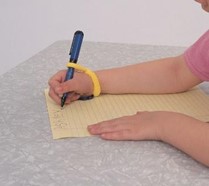 |
| Weighted pencil | Differs from pencil weights in that the entire pencil is enlarged and the weight is incorporated into the design of the pencil. | Used to improve proprioception in the hand during writing, often with children who have sensory processing difficulties. This type of pencil may also be used with children who have a mild to moderate hand tremor. | 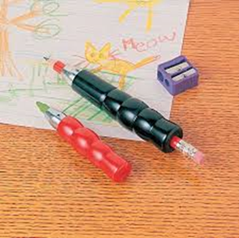 |
| PenAgain Twist N’ Write® Pencil | A specially designed pencil that accommodates the Adapted Tripod Grasp. | Made for children who use the Adapted Tripod Grasp. The pencil is formed to fit in the hand and position the fingers in a tripod position near the tip. | 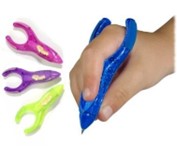 |
| Writing glove | A hand covering with holes or open tipped glove fingers for the thumb, index and middle fingers. The ring and little fingers must remain inside the glove. -A homemade version can be made using a sock that fits over the child’s hand. |
This glove is used to train children in forming a tripod grasp. The glove is often made as a puppet for added interest. | 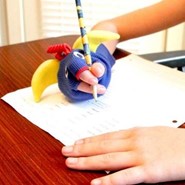 |
| Hand weights | Small weights that are sewn into neoprene hand-based gloves or holders. | These weights provide added stability and proprioceptive input to the hand during writing. Often used with children who have tremors or sensory processing issues. | 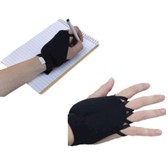 |
| Slant board | A writing surface that is placed at an angle to a flat surface. The angle may be fixed or adjustable. | Slant boards are used to improve a child’s wrist position during writing. The angle of the surface helps to facilitate the formation of a functional grasp by correcting wrist position. | 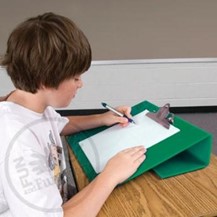 |